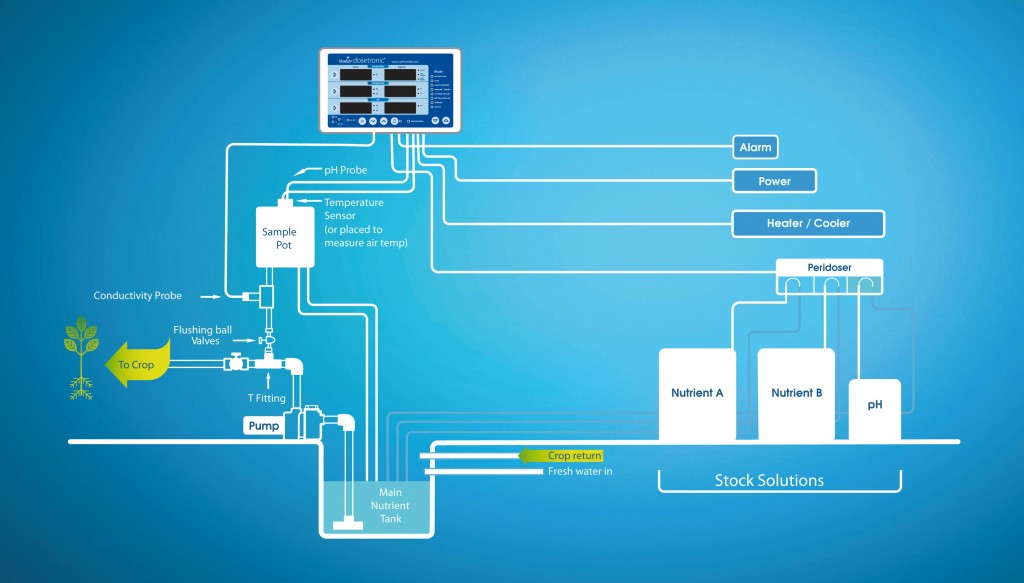The Importance of Automatic Nutrient & pH Dosing
Automatic Dosing is an important aspect that all commercial growers should consider for their business.
The main function of an Automatic Nutrient and pH doser is to maintain a consistent EC and pH level in the mixing tank at all times.
When using a recirculating system on a commercial scale there is a large surface area inside the greenhouse covered by crop foliage. The crop continually strips out nutrients and water from the recirculating solution in response to environmental conditions.
On clear, sunny days or on windy days the water consumed by the plants is very high due to the increased rate of transpiration. The water that is removed from the system by the plants is normally replaced automatically via a ball cock valve. The incoming fresh water that enters the hydroponic system typically has a higher pH level (e.g. 7 pH). This has the effect of raising the overall pH level in the mixing tank as well as diluting the nutrient strength in the mixing tank (The EC, CF, or ppm level).
If the pH level is over 6.2 pH (or higher) for a period of time then elements such as Iron and Manganese will drop out of the solution and become unavailable to the plants. This will lead to observable Iron and Manganese deficiencies in the crop.
The pH level in a hydroponic system is like having a set of keys which can open a row of cupboards. Each cupboard holds a different nutrient element. If the correct pH level is maintained around the root zone of the crop (e.g 5.8pH) then all of the cupboards can be opened allowing all of the nutrients to be made available to the plants.
If the pH level is higher than the desired level (e.g 6.8 pH instead of 5.8pH) then only a few cupboards will be able to be opened – the rest will remain locked. This means that the plants are unable to access all of the various elements they require for healthy growth.
The nutrient strength works in a similar way. If the nutrient solution is below the desired nutrient strength for a period of time (i.e 1.2 EC for lettuces) then the plants will not have the full balance of nutrients they require for sustained and healthy growth.
The rate of growth will therefore decrease and there will be no consistent texture to the plants. On some days they will have rigid foliage (from a High EC), on other days they will have soft foliage (from a Lower EC). A consistent EC level is therefore desirable so the plants have all the nutrients available to them in the correct balance.
Should the EC drop too low then there is a risk that any impurities in the solution (e.g sodium) will start to make up a larger proportion of the overall electrical conductivity of the solution. This can limit the uptake of essential elements and result in deficiencies.
An EC level which is too high can have a reverse osmosis effect. Instead of nutrients flowing from the nutrient solution into the plant (i.e. Flowing from a low concentration to a higher concentration), they do the opposite and flow from the plant back into the nutrient solution. This is due to the nutrient solution having a higher concentration that what is inside the plants. This has the effect of stripping the plant of essential elements and makes water uptake very difficult. The plant then collapses.
All of the above-mentioned factors are a continual risk for NFT growers who manually dose large tanks with just a hand held meter. Most growers who manually dose will experience these problems at some stage yet they do not realise how much it has impacted on the quality of their crop until they experience automatic dosing.
Manual dosing is fine for small systems but once the mixing tank size exceeds 1000 litres in a high transpiration area it becomes necessary to look at automation.
An Automatic Dosing System solves the problem in several ways:
- Incoming water from an automatic ball cock valve dilutes the mixing tank solution. The dosing controller immediately detects that the EC level has dropped and the pH has risen.
- The controller activates peristaltic pumps or solenoid dosing valves to add A, B & pH stock solutions to the mixing tank at preset intervals. The EC level rises to the desired set point and the pH level drops to the desired set point. Once the EC and pH levels are stable the controller goes on stand by as it continually monitors the solution strength.
- If the EC and pH setpoints are breached for any period of time beyond a predetermined level then the controller sounds an audible alarm to alert the grower.
- The EC, pH and Temperature level is clearly displayed with bright LED lights on the face panel of the controller. This allows the grower to clearly see at a glance what the tank solution strength is 24 hours a day.
- The grower no longer has to manually test and dose their mixing tank multiple times each day. This frees them up to focus on more important aspects of their business.
- If the grower was to put an hourly dollar value on the time they save then the money they save from using an automatic controller is significant.
- The market is more happy with the quality of the crop – When using an automatic dosing controller the crop always has a consistent texture, flavour, size and appearance.
- The faster growth speed means that the grower is able to fill all of their orders during peak times and annual yields improve overall.
- All of these considerations quickly pay for the cost of the control system and enhances the grower’s reputation in the market place.
For Automatic dosing control systems for recirculating systems Pure Hydroponics recommends the Bluelab Dosetronic Control System as featured on this website.
At a price of NZ$2,980.00 for a top of the line kit with Triple Peristaltic Dosing Pumps why wouldn’t you buy one?
Please talk to us for a formal quotation.



